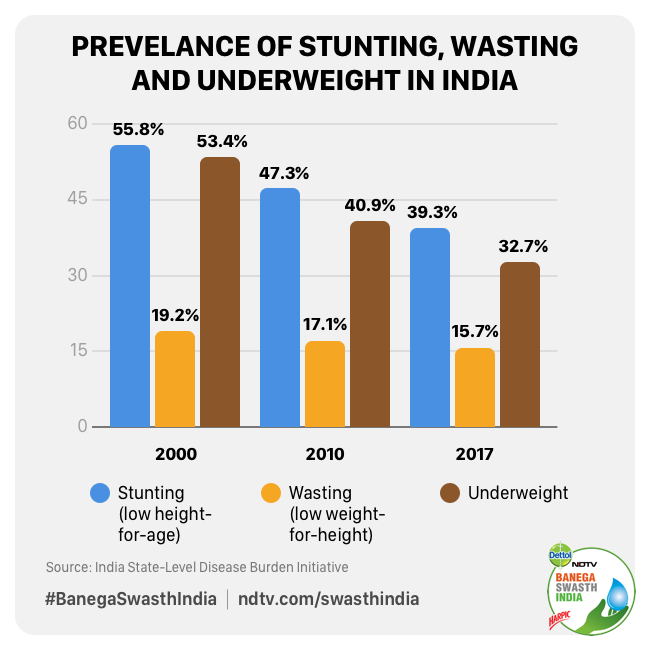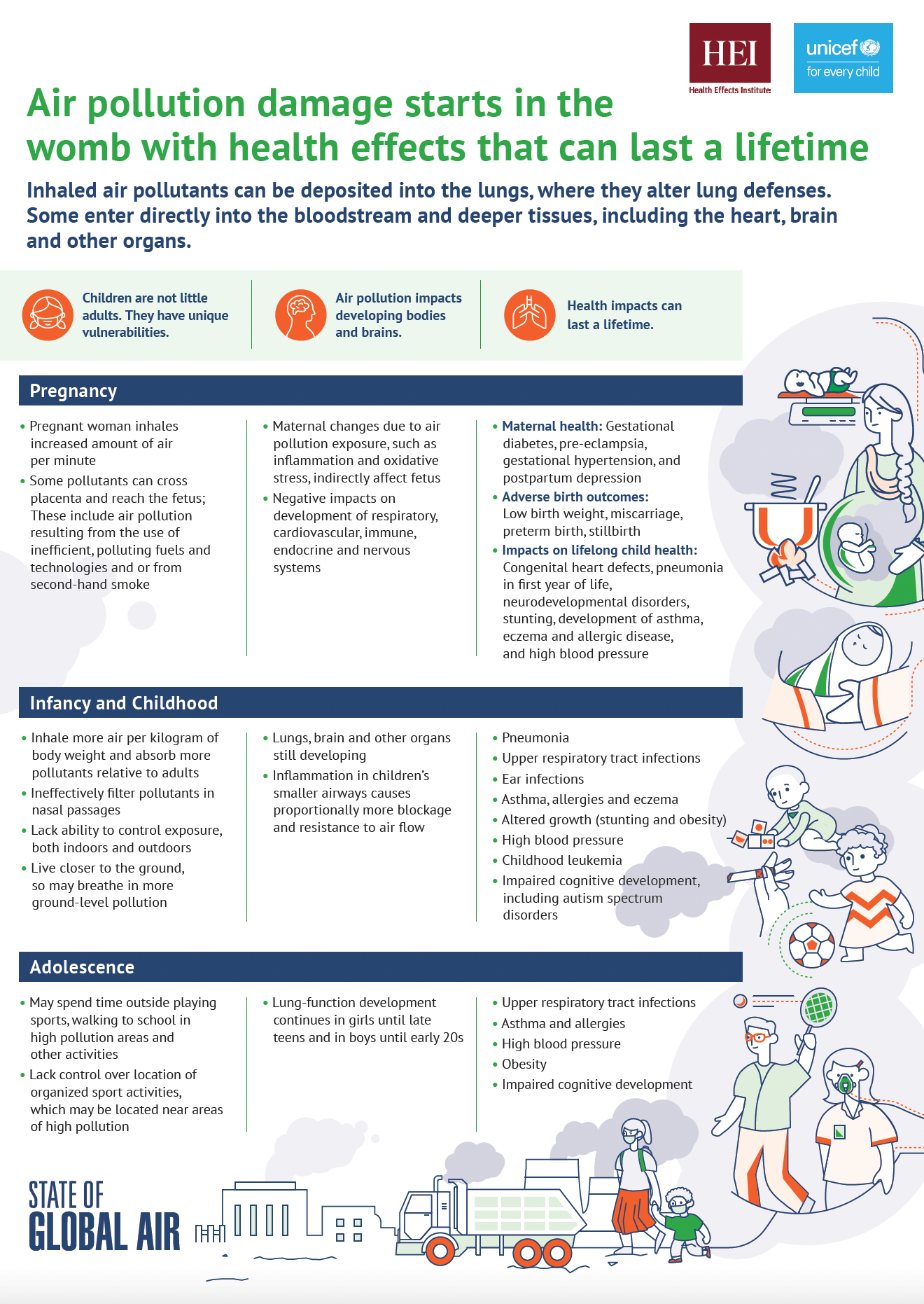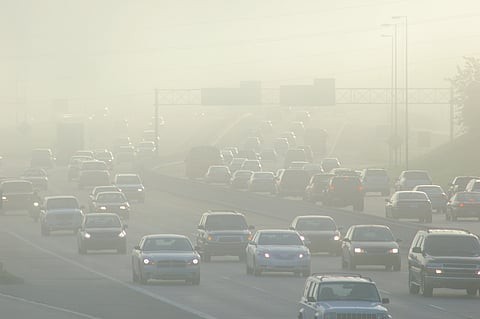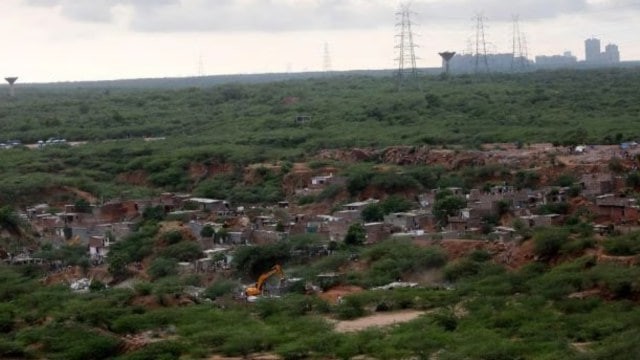Copyright infringement not intended
Picture Courtesy: ndtv
Context:
A research data shows how air pollution stunts growth in children by affecting body composition, , low birth weight, and reduced cognitive abilities
Key Findings of Air pollution impacts on Child’s growth:
- A large observational study by Pub med central found that early‑life exposure to fine particulate matter (PM₂. ₅) is associated with reduced height‑for‑age in children. For example, a 100 µg/m³ increase in PM₂. ₅ in the month of birth was linked to a 05 standard‑deviation decline in height‑for‑age. For a five‑year‑old girl this translates roughly to a height deficit of 0.24 cm.
- Every 10‑unit increase in PM₁₀ was associated with a 6% higher risk of neonatal mortality and 7% higher odds of ARI symptoms.
- Pregnant‑women exposure to ambient PM₂. ₅ and indoor air pollution in India was associated with higher odds of childhood stunting, underweight, and anaemia: e.g., each 1 µg/m³ increase in maternal exposure linked with 0.11 percentage‑point increase in stunting, 9 percentage‑point in underweight, 19 percentage‑point in anaemia.

Picture Courtesy: NDTV
What are the impacts of air pollution on children’s growth?
Health Impacts
- Respiratory problems: Exposure to fine particulate matter (PM₂.₅) and nitrogen dioxide (NO₂) increases the risk of asthma, bronchitis, and acute respiratory infections.
- Immune and neurological development: Chronic exposure can impair immune function and cognitive development, affecting learning and memory.
Growth and Nutrition Impacts
- Stunting and underweight: Long-term exposure during prenatal and early-life periods is linked with lower height-for-age and weight-for-age scores.
- Anaemia and malnutrition: Pollutants affect nutrient absorption and fetal growth, leading to higher prevalence of childhood anaemia.
- Case Study: National Family Health Survey data combined with ambient PM₂. ₅ exposure in India showed children in high-pollution areas were 5–10% more likely to be stunted than those in cleaner regions.
Educational and Cognitive Impacts
- Reduced attention span, memory deficits, and lower IQ scores have been associated with early-life exposure to air pollutants.
Economic and Social Impacts
- Increased healthcare costs: Families spend more on treatment of pollution-related illnesses.
- Lost productivity and education: Illness-related school absenteeism and impaired learning reduce long-term earning potential.
- Case Study: In Vidarbha, Maharashtra, frequent exposure to pesticide-laden air in cotton belts (a form of chemical air pollution) led to repeated child illnesses, causing lost school days and financial strain on households.
Environmental and Community-Level Impacts
- Children in heavily polluted urban or agricultural areas are continuously exposed to toxic air, compounding social inequality.
- Air pollution interacts with other environmental hazards (pesticides, water contamination), creating synergistic negative effects on growth and health. For e.g. Punjab and Haryana cotton belts show how pesticide drift in the air contributes to respiratory illness.

Picture Courtesy: UNICEF
What are the government measures to reduce air pollution?
National Clean Air Programme
- Launch & Objective: Initiated in 2019, targeting a 20–40% reduction in particulate matter (PM₂.₅ and PM₁₀) by 2025‑26 in non‑attainment cities.
- Implementation: Focused action plans for 132 cities identified with poor air quality.
Stricter vehicular emission standards
- Bharat Stage VI Norms: Enforced from April 2020, significantly reducing vehicular emissions.
- Impact: Cleaner fuel usage, reduced nitrogen oxides (NOx) and particulate matter emissions from vehicles.
Promotion of clean & renewable energy
- Fuel Switching: Expansion of LPG under the Pradhan Mantri Ujjwala Yojana to replace biomass and kerosene.
Industrial & source‑Specific Controls
- Regulations to control industrial emissions of sulfur dioxide (SO₂) and nitrogen oxides (NOₓ) in thermal power plants and other industries.
Monitoring data and enforcement
- Expansion of the ambient air‑quality monitoring network (air quality stations) and publication of the National Air Quality Index to inform public and policy.
Regional & Seasonal Action Plans
- Implementation of the Graded Response Action Plan (GRAP) in the Delhi‑NCR region, where specific actions (traffic restrictions, construction bans, industry audits) activate when air quality deteriorates.
What we can do next?
Strengthen Monitoring and Data-Driven Policies
- Expand real-time air-quality monitoring networks across all major cities and pollution hotspots. Integrate with decision support systems for predictive alerts and city-specific interventions. Example: The Delhi Pollution Control Committee uses real-time data to trigger the Graded Response Action Plan during winter smog events.
Promote Clean Transportation
- Accelerate adoption of electric vehicles, low-emission fuels, and public transport networks. Introduce incentives for EVs and stricter vehicle emission checks.
Industrial and Construction Emission Control
- Enforce strict emission standards, dust mitigation, and use of cleaner production technologies. Mandate compliance reporting and penalties for violations. Example: The Bhiwadi industrial cluster in Rajasthan installed air scrubbers and bag filters, leading to measurable reduction in SO₂ and PM₂.₅ levels.
Reduce Crop Residue Burning
- Promote mechanical residue management, bio-decomposition, and crop diversification. Offer subsidies for machinery and awareness programs.
- Case Study: In Punjab and Haryana, the adoption of Happy Seeder machines reduced stubble burning by 40% in pilot districts, cutting regional haze in Delhi-NCR.
Public Awareness and Community Participation
- Launch campaigns to educate citizens on pollution sources, preventive practices, and reporting mechanisms. Encourage community monitoring of local air quality.
- Example: The CITI-SENSE project in Bengaluru engaged schools and local communities in low-cost air-monitoring initiatives, creating public accountability and behaviour change.
Conclusion:
Air pollution in India poses serious health, environmental, and economic challenges, but coordinated action across transport, industry, agriculture, and energy sectors can significantly reduce its impact. Strengthening monitoring, enforcing regulations, promoting clean technologies, and engaging communities are key to creating healthier air and sustainable growth.
Source: Down to Earth
|
Practice Question
Q. Evaluate the effectiveness of India’s policy measures to control air pollution in urban and rural areas. Suggest ways to strengthen enforcement and public awareness. (250 words)
|













